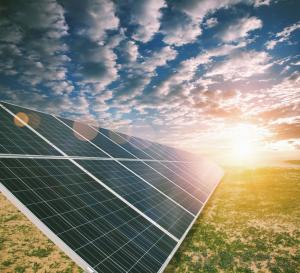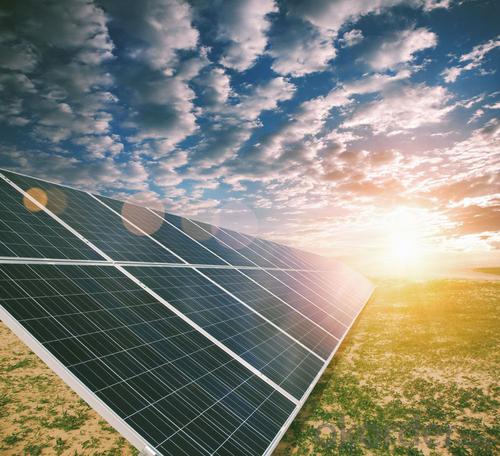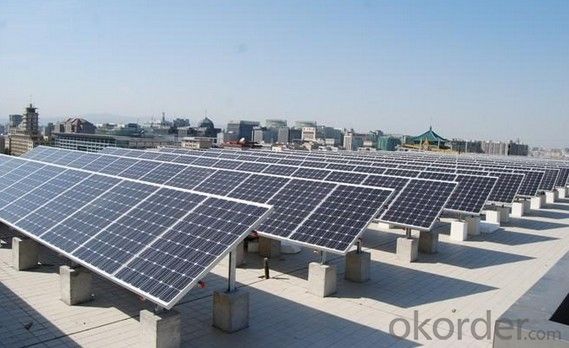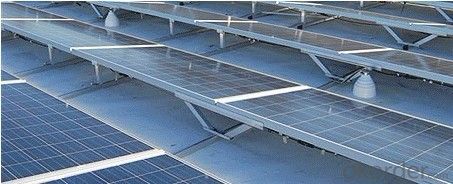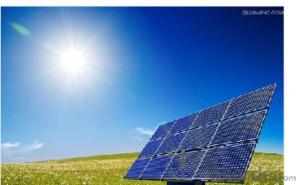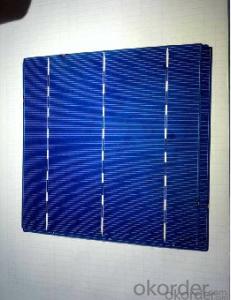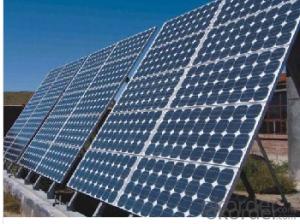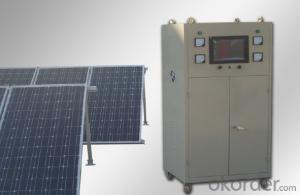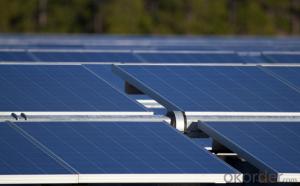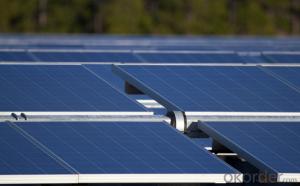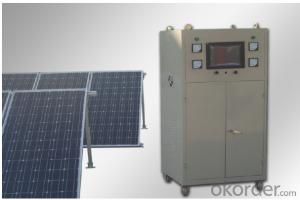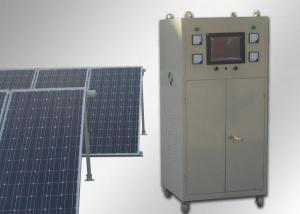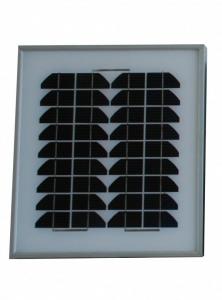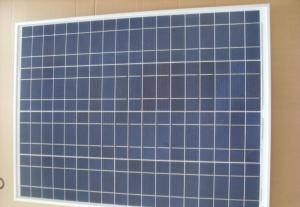Solar Home System CNBM-K8 Series 5000W Solar Panel - Solar Panels Long Beach CA
- Loading Port:
- Shanghai
- Payment Terms:
- TT OR LC
- Min Order Qty:
- 1000 watt
- Supply Capability:
- 100000000 watt/month
OKorder Service Pledge
OKorder Financial Service
You Might Also Like
Specification
1.Description of the Solar Panel
Solar Home System CNBM-K8 Series 5000W Solar Panel
CNBM Solar's photovoltaic module is designed for designed for large electrical power requirement. It is the optimal choice for both on-grid and off-grid power systems. CNBM Solar offers high performance of power per square foot of solar array.
2.Characteristics of the Solar Panel
Inverter
Inverter | Rated load power | 5000W |
| Outout wave | Pure sine wave | |
| Input voltage | DC 110V | |
| Output voltage | AC 220V | |
| Output frequency | 50HZ/60HZ | |
| Precision of output frequency | ±6% | |
| Solar panel | Pmax | 210W*24PCS |
| Vmp | 27.3V*6 | |
| Imp | 7.7A*4 | |
| Charger controller | Charger voltage & current | 110V/50A |
| Battery | Capacity | 12V150AH*9*2PCS |
| Support | aluminum | 6PCS/SET*4 |
| Power box | Spary paint iron box, with input, output, ammeter, volmeter, master switch and so on. | |
| Electrical loads in Winter (For Consult) | Electrical loads in Summer (For Consult) | ||||||||
| Name of Load | Power(W) | Quantity | Working Time per Day(H) | Working Days | Name of Load | Power(W) | Quantity | Working Time per Day(H) | Working Days |
| Color TV | 80W | 2 | 4 | 3 days | Color TV | 80W | 2 | 5 | 1.5 days |
| Fridge | 140W | 1 | 8 | 3 days | Fridge | 140W | 1 | 8 | 1.5 days |
| lamp | 11W | 4 | 6 | 3 days | lamp | 11W | 4 | 8 | 1.5 days |
| Computer | 150w | 1 | 4 | 3 days | Computer | 150W | 2 | 6 | 1.5 days |
| Heater | 1000W | 1 | 4 | 3 days | Air-conditioner | 1500W | 2 | 3 | 1.5 days |
3.Package Data of the solar Panel
| Part | Size(L*W*Hmm) | Weight(kg) | 20'(pcs) | 40'(pcs) |
| Power box | 840*620*1150 | 140 |
12Sets |
15Sets |
| Solar panel | 1610*830*100 | 450 | ||
| Battery | 1100*520*650*2 | 1100 |
4.Applications of the Solar Panel
1.Small power supply
2.transportation
3.Family power of lamps and lanterns
5.IMages of the Solar Panel
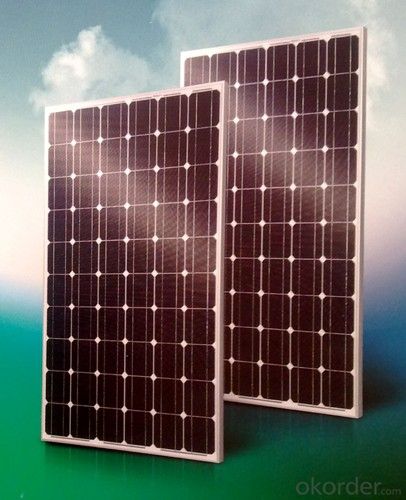
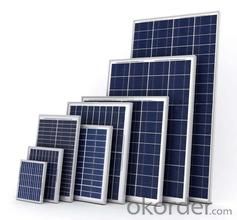
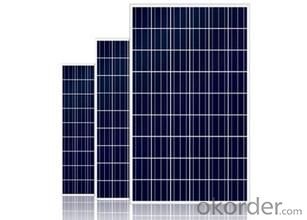
FAQ
1. Q: Do you have your own factory?
A: Yes, we have. Our factory located in Jiangyin city, jiangsu province.
2. Q: How can I visit your factory?
A: Before you take off from your country, please let us know. We will show you the way,or arrange time to pick you up if possible.
3. Q: Do you provide free sample?
A: Usually we do not offer free sample
4. Q: Could you print our company LOGO on the nameplate and package?
A: Yes, we can do that.
- Q: Can solar panels be installed on assisted living facilities?
- Yes, solar panels can be installed on assisted living facilities. In fact, installing solar panels on these buildings can be highly beneficial as it can help reduce energy costs, promote sustainability, and contribute to a greener environment. Additionally, solar panels can provide a reliable source of renewable energy, helping to ensure a more reliable power supply for the facility and its residents.
- Q: Can solar panels be used in areas with high snowfall?
- Yes, solar panels can be used in areas with high snowfall. However, it is important to consider the design and installation of the panels to ensure they can withstand heavy snow loads and are positioned at an optimal angle to maximize snow shedding. Additionally, regular maintenance, such as removing snow accumulation, may be necessary to maintain their efficiency during winter months.
- Q: Are there any noise concerns with solar panels?
- No, there are no noise concerns with solar panels. Solar panels produce electricity by converting sunlight into energy and do not generate any noise during their operation.
- Q: Lower solar panel/wind turbine prices allow wider applications, hence a great help to a greener mother earth!
- Answered okorder /. They were initally so lame (and this is related to their general paranoia) that they cut deals to place the turbines before they secured corridor access to substations. Load gun, cock it, aim at foot, shoot.
- Q: i know that a solar panel of square meter generate 000 watts on a clear and sunny day, but i need to know the time rate. is it 000 watts per day or per hour? Thanks.
- 000W/square meter is the standard input rate that solar panels are rated by. Watts are a rate, like miles per hour. Depending on the technology, you might get as much as 20% of that as an output of the panel. To determine the amount of power generated, you need to multiply the rate by time. Just like in a car, going 50mph for 5 hours sends you 250 miles. You look at the rating of the panel, if it is a 50 watt panel, in 5 hours AT THAT RATED INPUT, you would generate 250 watt hours (wh). You can find charts that tell you how many sun hours are available a day. As the sun is generally strongest at solar noon, it is weaker in the morning and afternoon. They have averaged the power of the sun throughout the day, and said for each location, how many hours equal to 000W/Msq are in a day. Five is a nice average number. So, if you figure 000W input in a square meter, 20% output, or 200W (the rate) times 5 sun hours (time) = 000Watt hours, or kilowatt hour ( kwh) (quantity) can be generated from a square meter of panels in a day.
- Q: I'm making a model of a solar photovoltaic tower for a school project. I need a way to store energy, and we thought about using capacitors (mainly because of our somewhat limited funding). The tower will have a small photovoltaic panel (around the size of a laptop keyboard with number pad) and some (around 50) quot;heliostats(just the mirrors, no moving parts). What kind of capacitors should i use? and would a capacitor bank be better? i am getting confused with all those uF, pF and can't see the difference.Thanx in advance
- If you have a rechargeable AA battery (NiMH or NiCad) that might work. You're not going to get much power from that size array anyway, especially if it is not in full sunlight. A Farad (F) is ,000 times bigger than a milliFarad (mF), which is ,000 times bigger (stores ,000 times more) than a microfarad (mF). pF and nF are so tiny do not even look at them. With your size array voltage might not be a problem, but be sure to check that the voltage rating of the capacitor is less than whatever the array can make. Some people buy those solar yard lights, which seem to break often. You might be able to get some and use the contents for your project (pre-wired circuits).
- Q: Is it as simple as buying the panels, an inverter and plugging it into a wall-socket, assuming it would just send power back into the outlet and supplement my house's electrical usage, or... Is it not that simple?Remember, I'm talking about a SMALL system, and I don't care how little power it'd make, or how uneconomical it would be.
- For one thing, you would be trying to supplement the entire electrical grid. Same reason you must have a cut out relay for an emergency generator. Cause without one, you generator would be trying to power the whole regions electrical system. You could set up a solar system to just power specific things, like a gate opener, etc. But thy would have to be wired separate from the house a.c. electrical system.
- Q: how long till a 50 watt solar panel pays itself off in buffalo, ny if its $500. i have national grid and heres the link to the rates. i am residential.
- the Department of Energy has a ' solar hours calculator for locations around the US factoring in hours of sunlight.....the other factor is how perpendicular to the sun the panel is.....as a wild guess I'd say Buffalo's solar hours factor is about 3....which means as an average over 365 days you get 3 hours a day of maximum ( 50 watts ) output. So 3 x 50 x 365 = 64.25 kWh a year. At, say, 5 cents a kWh, you're making $24.63 a year worth of electricity. See why the houses of upstate New York..let alone Ohio or Virginia or Georgia.....aren''t covered in panels?
- Q: I'm trying to charge rechargeable AA batteries with a solar panel. What gauge wire should I use to connect the panel to the batteries? I know I'm not going to have a lot of current going through so the wire size doesn't really matter. Can the wire be too thick thoShould I ugh? Should I use a diode to keep the batteries from overpowering the circuit? If so, what size diode? My panel is 4.8V 50mA. Can I just hook the panel straight into the batteries or do I need something else?
- In order: .? Just about any wire will do.? You can handle 50 mA over just about anything, even 28 gauge telephone wire.? Your biggest problems are probably going to be mechanical stress (you want stranded wire instead of solid, to avoid breakage) and dealing with the size of larger wires. 8 gauge speaker wire may be a good optimum. 2.? You need a diode.? If you're charging NiMH or NiCd cells you're going to have about .25 volts/cell; you can charge up to 3 of them in series with a 4.8 volt panel.? The solar panel is a bunch of diodes itself, but they're leaky in the reverse direction; the diode prevents the batteries from discharging themselves back through the panel.? You want a Schottky-barrier diode, because the forward voltage drop is about 0.2 volts instead of 0.7 volts for a regular silicon rectifier.? This gives you maximum current output from your panel.
- Q: How much electricity can a solar panel generate?
- The amount of electricity a solar panel can generate depends on several factors such as the size and efficiency of the panel, the amount of sunlight it receives, and any shading or obstructions. On average, a typical solar panel can generate between 250 to 400 watts of electricity per hour.
Send your message to us
Solar Home System CNBM-K8 Series 5000W Solar Panel - Solar Panels Long Beach CA
- Loading Port:
- Shanghai
- Payment Terms:
- TT OR LC
- Min Order Qty:
- 1000 watt
- Supply Capability:
- 100000000 watt/month
OKorder Service Pledge
OKorder Financial Service
Similar products
Hot products
Hot Searches
Related keywords
